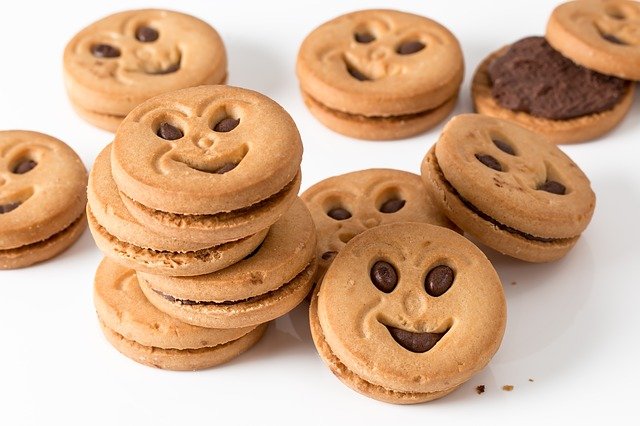By Tim Lambert
Early Cakes and Biscuits
The word biscuit is derived from the Latin words bis cotus, meaning twice baked. The idea of making biscuits goes back to the Romans. However, biscuits, as we know them, were developed in the Middle Ages.
People have eaten pancakes since the Middle Ages. (The earliest recipe dates from the 15th century). At that time, people were supposed to fast certain foods during Lent, the 40 days before Easter. They were also supposed to confess their sins. The old word for confessing was shrive, so the day when confessions were made was shrive or shriven Tuesday. Later, it became Shrove Tuesday. At that time, making pancakes was a useful way of using up food like butter and eggs before the period of fasting.
The Tudors were also fond of sweet foods (if they could afford them). The rich ate preserved fruit, gingerbread, sugared almonds, and jelly. However, in the 16th century, sugar was very expensive, so most people used honey to sweeten their food.
Marzipan was introduced into England in the Middle Ages. It is a paste made of almonds and sugar. The Tudors used marzipan to make edible sculptures of animals, castles, trees, and people called subtleties.
From the Middle Ages, people ate simnel cakes. (Simnel was originally the name of fine flour. There is a Simnel Street in Southampton).
At Christmas, the Tudors enjoyed mince pies, but they had far more significance than today in that they had 13 ingredients to represent Jesus and the apostles, they contained fruit (raisins, currants, prunes) and spices (cloves, mace, black pepper, saffron) and also mutton to represent the shepherds. The fashion was for them to be shaped like a crib, but this practice was banned by Oliver Cromwell.
The Tudors also had Christmas pudding, but this was shaped like a sausage and contained meat, oatmeal, and spices. Twelfth Night cake was a fruitcake baked with an item like a coin or dried bean; whoever found it became King or Queen or host for the evening’s entertainment. Banbury cakes were first mentioned in 1586.
Meanwhile, scones were first mentioned in the early 16th century.
In Tudor times, people ate spiced buns on Good Friday. The first mention of crosses on them was in the 18th century. So by the 1700s, people were eating hot cross buns. Meanwhile, bread and butter pudding also became a common dish in the 17th century.
The earliest recipe for crumpets dates from the beginning of the 18th century (although they may have existed before then). Bath Oliver biscuits were invented by William Oliver in the mid-18th century. Eccles cakes also date from the 18th century.
Modern Cakes and Biscuits
In the 19th century, with the Industrial Revolution, the mass production of cakes, biscuits, and jelly began. Many new cakes were invented. In the 19th century, people began to eat birthday cakes. Battenberg cake was invented in the 19th century. So was the Swiss roll. Victoria Sponge was also invented in the 19th century (it was named after Queen Victoria). Kendal Mint Cake was invented in 1869. Doughnuts also date from the 19th century.
Bakewell tart is known locally as Bakewell pudding. It was, supposedly, invented by accident in 1859. However, it is now known it was made before that date, and the accident story is a myth. Tarte Tatin was invented in the 1880s. Pavlova was invented in the 1920s. Jaffa cakes went on sale in 1927. Twiglets date from 1929, and Penguins were introduced in 1932.
Several new biscuits were invented in the 19th century. Nice biscuits were invented in about 1860. Other new biscuits included the Garibaldi (1861) and the Cream cracker (1885). Alexander Grant invented the digestive in 1892.
In the 20th century, new biscuits were introduced. Custard creams were invented in 1908, and Bourbons were invented in 1910. Chocolate digestives went on sale in Britain in 1925. Ruth Wakefield invented chocolate chip cookies in 1938. HobNobs were introduced in 1985. A chocolate variety was introduced in 1987.
In Britain, National Biscuit Day is 29 May.

Last revised 2025